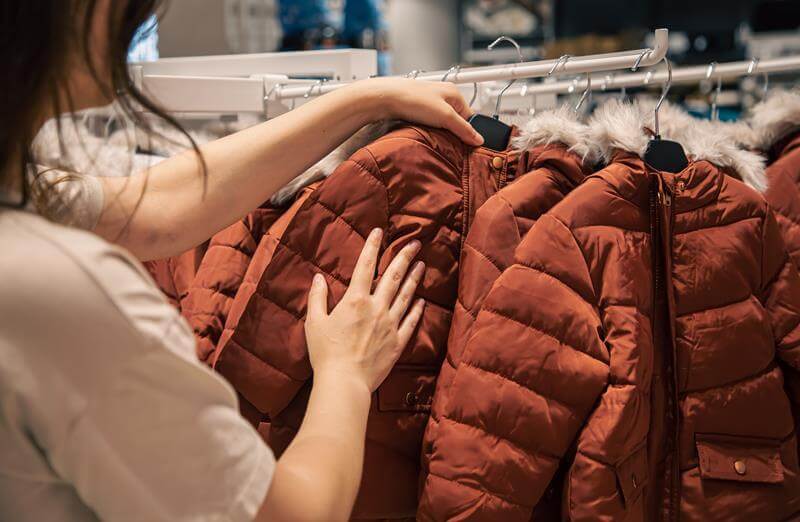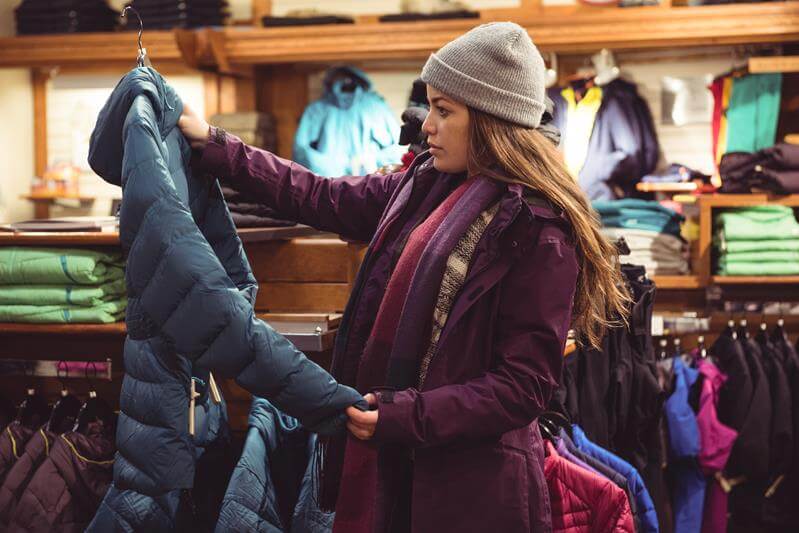What Makes a Winter Coat Sustainable?
First things first. So, let’s clarify what criteria a product must meet to be called sustainable outerwear. All of them concern raw materials for the manufacturing fabrics, accessories, and care products. Thus, to ensure waterproofness and protect the product from precipitation, it is necessary to create a water-repellent layer. To avoid toxic non-rinse chemicals, look for brands that use pure or recycled polyester (such as PFAS or durable PFC-free water repellent (DWR)) certified by the Global Recycled Standard (GRS).
The fabric for sewing the coat, the lining of the coat, or the filler that provides warmth must be made of organic or recycled certified fabrics. Suppliers of raw materials must also have sustainable ecological politics and open information about the logistics chain. Some sustainable outerwear brands produce products close to their raw material suppliers to reduce their carbon footprint by reducing fuel consumption.
Why Choose Sustainable Winter Outerwear?
Awareness of the importance of the origin of fabrics, the sustainability of raw materials, and the green policy of manufacturing affect not only the quality and durability of the product but also the contribution to the environment. Clothing is one of the most environmentally harmful industries. It generates 20% of all wastewater worldwide and 10% of the world’s carbon emissions. That’s more than all international air travel and shipping combined. 85% of clothing and footwear ends up in landfill within a year of purchase.
Learning about sustainable brands, their collaborations with eco-activists, and other green initiatives on sustainable outerwear collections can save valuable resources and teach people how to live a balanced life with an understanding of the uniqueness and value of the environment.
The eco-friendly trend is blooming, and brands that conscientiously support it. They implement it in their sustainable winter coats, certainly gaining a strong competitive advantage and attracting a new audience, raising a generation of conscious consumers.

Top Materials for Eco-Friendly Winter Coats
Here are some wool varieties to consider:
- Organic wool: produced without the use of harmful chemicals on animals, pastures, or animal feed products. Animals are raised on organic farms and are hand-sheared during warmer months to protect the animals from the cold.
- Recycled wool: helps reduce waste and chemical pollution as wool is one of the most recycled materials due to its natural antimicrobial and anti-odor properties, which help maintain its durability and purpose.
- Ethical wool: Alpaca, Merino, and Cashmere – requires Certified Humane, Certified Animal Welfare, Responsible Wool Standard (RWS), ZQ Merino Standard, Climate Beneficial Wool, and Certified Organic Wool improvement.
Consider your skin’s sensitivity when checking the composition of the lining material of your coat. If you’re sensitive to synthetics, avoid any polyester lining, even recycled ones. Instead, choose natural fibers like merino wool, alpaca wool, organic cotton, linen, and Tencel. Check for chemical certifications like Bluesign and Oeko-Tex to make sure the dyes and finishes used are truly safe for your skin.
Best Sustainable Outerwear Brands
Icebreaker is a New Zealand brand that makes PFC-free merino wool, Tencel, and cotton coats, easy to layer and great for outdoor adventures.
Best for: nearly plastic-free, maintaining a transparent supply chain with its long-time partners.
Price Range: $285 – $375
Sezane is a luxury-certified B-Corp that offers wool, cotton, and viscose coats, working toward full transparency throughout its supply chain.
Best for: certified by Oeko-Tex, FSC, or RWS, and its shipping boxes are made with recycled cardboard.
Price Range: $265 – $900
Reformation offers eco-friendly coats crafted from renewable materials like lyocell, recycled cotton, deadstock fabrics, and vintage textiles. Their collection also includes traceable sweaters made from regenerative cotton and wool, low-impact alpaca yarns, ocean-sourced regenerated nylon, and recycled polyester.
Best for: Reformation has received its Climate-Neutral certification and continues to reduce excessive use of natural resources. FactoryForward initiative was implemented to help supply chain partners make the production 100% ethical and zero-waste by 2025.
Price Range: $105–$840
TenTree is a sustainable brand of winter coats that uses low-impact or recycled materials, and PFC-free DWR coating.
Best for: It uses recyclable shipping mailers and FSC-certified tags and inserts in its packaging.
Price Range: $108 – $328
Amour Vert uses GRS-certified recycled polyester, organic cotton, and leather-like organically grown and harvested cacti. Some available jackets and coats use ethical wool from non-mulesed Merino mills in Italy and Australia.
Best for: The Brand has a separate resale marketplace for pre-loved clothing under ReAmour and utilizes compostable packaging with every order.
Price Range: $80–$530
Everlane produces coats for women and men made of recycled materials, 100% recycled polyester, and nylon for technical outerwear. It has partnered with Italian mills to wash and comb worn cashmere and wool to produce new yarns. Natural wool products are made from non-mulesed sources, enforcing ethical standards in procuring alpaca wool when needed.
Best for: It has pledged its commitment to the Paris Agreement, which aims to cut carbon emissions in half by 2030 and be net zero by 2050. So far, the company has secured various sustainability certifications, started its initiative to eliminate all new plastic from its supply chain in 2021, and moved to organic cotton use by 2023.
Price Range: $38 – $398
How to Care for Your Outerwear
Every item of your wardrobe requires proper care. Autumn or winter sustainable coats are no exception. To keep your outerwear neat and retain an attractive appearance for a long time, remember to provide proper care. This will not only extend the life of your favorite item but also save money on buying a new one.
So, the following general rules for coat care can be highlighted:
- Do not leave your outerwear damp. After heavy snowfall or rain, place the item on a terry towel. It will quickly absorb excess moisture.
- Regularly clean your coat with a special brush. This will help get rid of minor dirt. Also, use a sticky roller brush and a machine to remove pellets.
- Hang the item on a hanger with hangers to maintain its shape and avoid creases.
- At the beginning and end of the season, it is recommended to take the coat to a dry cleaner for thorough and professional care.
- Store the item in a regular closet. This will protect it from sunlight and dust in a special cover.
These general recommendations will help you maintain the expensive look and beauty of your favorite outerwear.
Tips to Choose the Perfect Sustainable Winter wear
Alongside meeting eco-friendly standards, it’s essential to consider durability and care details for sustainable fabrics. Some sustainable outerwear brands offer repair or care services to help extend the life of your coat. Packaging also speaks volumes, as your sustainable winter coats shouldn’t come in plastic or paper wrappers that will end up in the trash once you open the package. Look for brands that use biodegradable, recyclable, or compostable materials whenever possible. You can also look for FSC certifications to ensure that the paper packaging is sourced responsibly.
Conclusions
Conscious consumption is a philosophy with a deep meaning that shapes and educates a new generation of people. Moderate consumption, reuse, minimizing waste accumulation, careful use of natural resources, and creating ecological alternatives around oneself and for oneself – this is the task of a conscious consumer. Clothing as a way of self-expression and a source of comfort is an integral part of such a style. Therefore, this selection of reviews and searches for sustainable coats is a small step forward towards an ecological future. We hope this article has helped you with the basics.
“We must think about what we leave for future generations and strive to make our consumption responsible and eco-friendly.” – Stella McCartney.
FAQ
Amid billions of searches for guidance on selecting a winter coat that offers both lasting comfort in the cold and supports sustainable outerwear brands, we’ve identified the top three most popular questions—read them below
What is the best natural material for winter coats?
Natural fabrics have high thermal and breathability properties, retaining body heat and removing moisture, preventing the feeling of stickiness under layers of clothing. They are alpaca or merino wool, cotton, or linen. Also, pay attention to what accessories are made of (buttons and zippers) – the best ones are made of corozo, not plastic.
Are wool coats ethical?
There is no single answer to this question. Wool for sustainable coats can only be ethical if brands partner with openly positioned cruelty-free farms. Animals on such farms graze in wild nature in open spaces (meadows and mountain slopes). However, since not all wool suppliers have an open policy of awareness and transparency, the truth is left in the shadows. Try to support brands with quality standards that respect nature and animal protection.
What is the best coat for freezing weather?
The best coat to wear in winter is a puffer or leather to protect you from cold weather being insulated and waterproof. The ideal choice for winter weather can be made of polar fleece, wool, natural fiber, and synthetics.

Author

Anna Smirnova
Content writer on https://rythmoftheworld.com From my practicing in science, I brought the skills of discovering, analyzing, and explanation. I adore art, photography, traveling, hiking, and winter.



